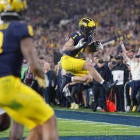
The House v. NCAA settlement signifies a line in the sand. Not since 1984's NCAA v. Board of Regents of the University of Oklahoma have we seen a court ruling fundamentally alter the landscape of college athletics in this manner.
Not only does the settlement distribute roughly $2.8 billion in NIL backpay, but it also establishes a framework for future athlete revenue-sharing. Details still need to be sorted out, but it's a landmark step toward getting players in on the financial windfall they generate.
While the NCAA is responsible for roughly 40% of the settlement, much of the burden will fall on its member universities. The power conference schools are poised to contribute roughly 24% of the bill, leaving the often cash-strapped schools that comprise the remainder of Division I to cover the remaining 36% of the total settlement.
It's a historic moment in college sports that will generate multiple layers of fallout over the months and years to come. For now, here's an early look at the winners and losers from the House v. NCAA case.
Winner: The players
At long last, the players will get a cut of the billions of dollars flooding into the NCAA, conferences and individual schools. While the advent of NIL compensation was a step in this direction, those payments come largely through third-party collectives funded by big-money boosters and average fans. Now, the athletic departments themselves are finally on the hook financially for the labor that fuels their products and underpins their budgets. While the $2.8 billion owed in backpay is eye-popping, that figure will be dwarfed by the amount paid out to athletes in the coming years as part of the revenue-sharing framework established by the case.
Loser: The NCAA
For decades the NCAA fought on behalf of its member schools to preserve the amateurism model. This officially marks the end of that war. While the House treaty ensures the NCAA's survival as an organization, it will be a diminished entity on the hook for $1.1 billion of the settlement. That money will come from its reserves and through budget cuts, as CBS Sports' Brandon Marcello reported. That means some lean years are ahead for the NCAA office in Indianapolis as it finds its footing in a new era. While the alternative to a settlement would have been a potentially fatal adjudication, this is still a big loss for the NCAA.
Winner: Boosters and fan pocketbooks
Athletic departments are still going to need boosters to make big-money contributions, arguably now more than ever as their budgets are squeezed amid a decrease in NCAA distributions and the advent of revenue-sharing. But the boosters and casual fans won't be so directly needed to fund talent acquisition. The term "booster fatigue" has become common in the college sports lexicon. Now, the primary onus for paying the players will be on the athletic departments. That takes financial pressure off supporters, who are already shelling out for seat licenses, season tickets, travel, merchandise, parking, concessions, cable packages and all the other expenses that come with being a college sports fan.
Loser: Competitive balance
Power conference schools are preparing to share in the neighborhood of 20% of their media rights revenue with the athletes. The total could surpass $20 million annually per school, further establishing the big boys as the premier destinations for the nation's most talented players. Even if Group of Five or FCS teams set aside a similar percentage of their media rights deals for player compensation, it will pale in comparison and widen the gulf between the haves and have-nots. While the big-brand schools have always been the preferred landing spots for most high-profile players, the compensation model of the pre-NIL era was equal: Players weren't supposed to make anything. Then came NIL and the abolition of transfer restrictions, which made it more difficult for the resource-strapped programs to attract and keep talent. This settlement is another setback for the competitive aspirations of those outside the power conference structure.
Winner: the NCAA Tournament
While a larger portion of the bill for the House settlement is falling on the other 27 Division I conferences than on the Power Four, there is a silver lining for the little guys: Preservation of the NCAA Tournament. The settlement essentially tethers the power leagues to the NCAA for the next decade. That makes a full-on breakaway from the Power Four to form its own postseason hoops championship even less likely than it was before. Whether the Big Dance will expand is another question entirely, but we should still see the Cinderellas getting a crack at the blue bloods each March.
Loser: Non-revenue sports
The fate of non-revenue sports (which at most schools means everything besides football and men's basketball) will hang in the balance as athletic administrators grapple with the financial ramifications of the settlement. In addition to potential measures such as staff cuts and delayed facilities upgrades, non-revenue sports could be on the chopping block. That's especially true for departments already struggling with financial solvency. With hits coming to their NCAA distributions and pressure rising to pay players in high-profile sports, don't be surprised to see lower-tier Division I departments axe some of their financially inefficient programs for the sake of making ends meet.
Winner: The lawyers
Billable hours remain undefeated, and the gravy train is just beginning for the lawyers. Untangling the minutia of the House lawsuit will take an army of attorneys and paralegals months and maybe even years. There's ample legal work ahead to make sure the backpay ends up in the right hands. While the House case may be the one that goes down in history, it won't be the end of the legal issues for the evolving and unstable business model altered by the settlement. Murky Title IX implications and the continued pursuit of an antitrust exemption also offer more work for law firms.
Loser: Mid-level department bloat
As of Sept. 30, 2023, Ohio State's Human Resources database lists 139 athletic department employees with salaries exceeding $100,000. That's just one example of the bloat that infiltrated programs around the country as they searched for a place to deposit the annual fortune generated from high-profile college football. A weighty chunk of Power Four revenue is now expected be used to pay the players, which could mean trouble for the army of associate, executive, assistant, deputy and senior athletic administrators employed by most power conference schools. This ruling will also likely hasten the push from private equity firms to take a seat at the table and get a say in how athletic departments of the future are made up. That could spell the end of rising salaries and cushy gigs for the mass of mid-level administrators who've claimed a foothold in the fabric of college sports over the last 25 years.
Winner: the Big Ten and SEC
We'll steal a blurb from my colleague Shehan Jeyarajah, who broke down how the House settlement will impact college athletics in years to come and singled out the Big Ten and SEC as two clear winners here.
"If you wonder why Texas and Oklahoma went to the SEC, while USC and UCLA defected to the Big Ten, the potential cost of litigation played a significant role. A massive new Big Ten television contract could essentially fully cover the cost of the new reality for the Trojans and Bruins.
"For other schools, it won't be as simple. The ACC's total ESPN television contract cleared $30 million annually per school only in the past few seasons. The ACC and Big 12 both distributed approximately $44 million per school overall. For comparison, the Big Ten TV contract alone could be worth more than $75 million per school annually."
















